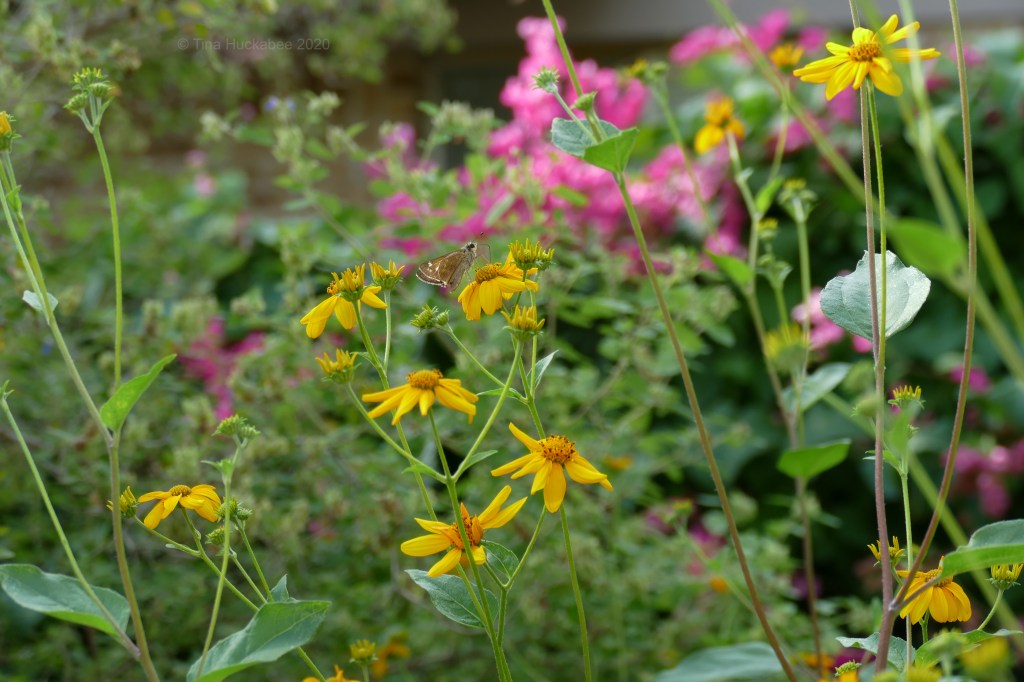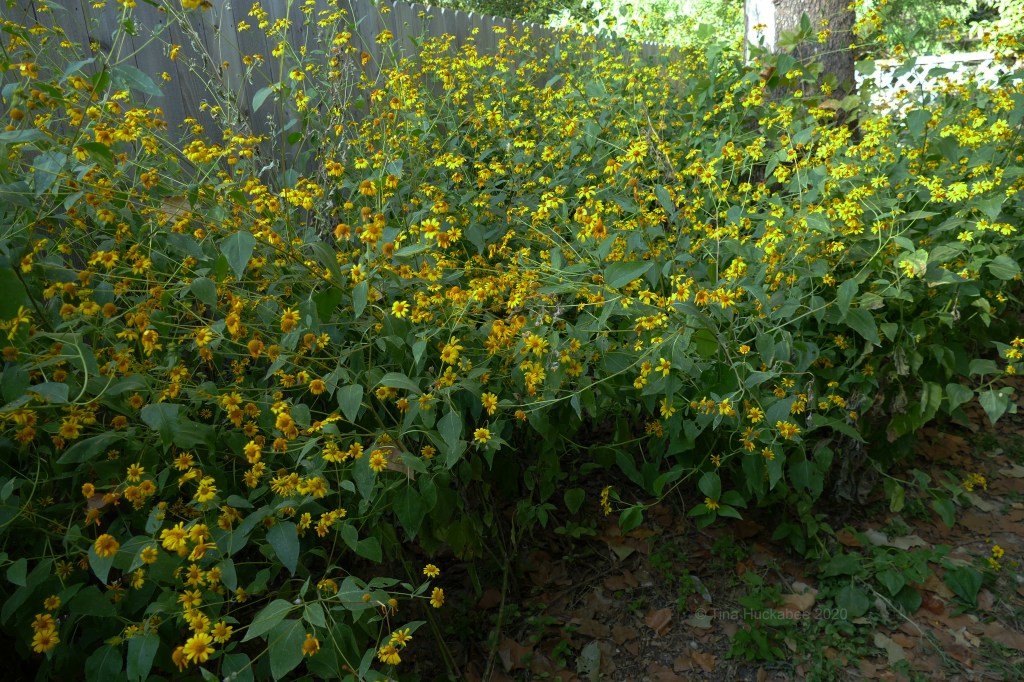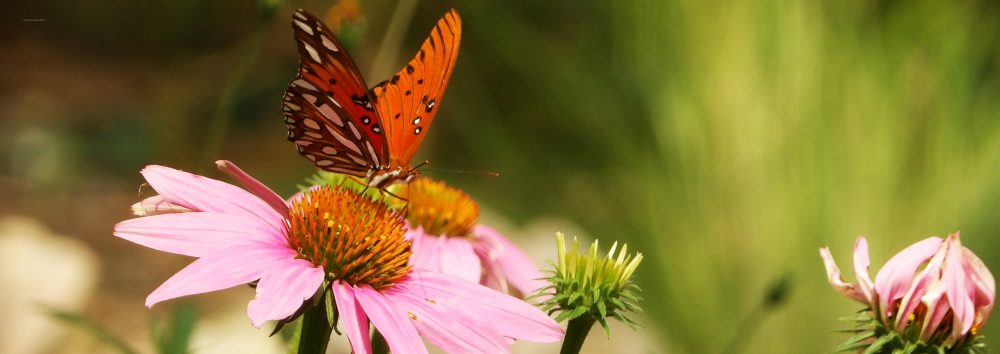Spring has sprung!
Oh, that’s not right. But it is. Sort of.
Here in Central Texas, zone 8b, we’re enjoying our second spring, so called because the native annuals and perennials burst out with a bevy of blooms, celebrating the end of the hot season and the return of the cool.
And how cool are these lovelies? Gregg’s mistflower, Conoclinium greggii, are native to the southwest–Arizona, New Mexico and Texas. A mostly autumn blooming groundcover, established plants produce a smattering of blooms during spring and summer. During months when the fuzzy blooms are on hiatus, the stars of this plant are the palmate, light green leaves. The combination of the lavender-blue blooms and the cheery green leaves gladdens this gardener’s heart.

This time of year, you’d be hard-pressed to find a mistflower group who doesn’t host a remarkable variety of pollinators, they’re all over these pretty blooms. That also gladdens this gardener’s heart.

Coral vine, Mexican creeper, Antigonon leptopus, is an old-fashioned vine, resplendent in dripping pink in the latter part of summer and well into the fall months.

I’ve grown this vine in my garden for many years. It resided in the back garden. It returned after winter each spring, climbing up and over a trellis during during the growing season, until that spot became too shady. About 3 years ago, I moved the hefty root to my front garden, where the vine receives ample sun. The vine is happy here, as are the honeybees, small native Perdita bees, and various butterfly types.
I love this vine and am comfortable with it where I garden, but Coral vine is designated as an invasive species here in Texas (click on the link above for more information) and so should be grown with caution and attention to nearby areas. I wouldn’t plant Coral vine if I lived near a greenbelt or natural area, because it’s known to seed out and once it is in a uncontrolled area, it can spread and displace native plants, which is never a good thing. In my years of hosting this vine, I’ve only seen 2 or 3 seedlings that germinated at the base of the plant. I’ve never seen birds nibble at any seeds, so I plan to keep it where it is–pink and pretty and full of the good stuff for bees and other pollinators.

The happy faces of Fall aster, Symphyotrichum oblongifolium, arrive along with cooler temperatures–which makes everyone happy. These cheery, lavender asters don’t bloom for long, maybe 2 weeks in total. I have several groups of them, each of which bloom with slightly different times, so in my garden, the aster show lasts through much of October. For the rest of the growing season, the plant grows as a low shrub/ground cover with attractive, diminutive leaves. In winter, a hard freeze will knock back most of the foliage, leaving an evergreen rosette until new spring growth.

Another pollinator magnet, the asters always have plenty of nectaring business and often host rarely seen winged things. This Syrphid fly (?) is unknown to me; the closest ID I could find is Hoplitimyia constans. I’ll continue looking for an identification and update if I find a match. It’s a handsome critter, no doubt.

Sunshiny Plateau goldeneye, Viguiera dentata, is another native perennial, seeding out with abandon and rocking its yellow vibe with verve. Bees, butterflies, and gardeners all love this member of the Asteraceae family. I just realized that 3 of the 4 plants profiled for this post belong to this prolific family. Aster plants are garden stars!
Goldeneye volunteers pop up in my garden and depending upon where they land, I keep–or not. There are so many, I don’t mind tossing out a few. Well, I don’t mind too much. Goldeneye individuals grow tall, so I make some (rather) lame attempts at control, pruning it back a couple of times during summer. But once the fall rains arrive and Goldeneye send forth their end-of-season stems, gloriously topped with dabs of sunny delight, I don’t mess with them.

I stand, admire, and don some sunglasses.

In a work/storage area, I let these seed out, grow up, and have at it! The bees and butterflies love this buffet of pollen-n-nectar. The fun doesn’t end when the blooms end, because wrens and finches of various sorts swoop in for the seeds, assuring a good crop of Goldeneye for the next year.

There are always more Goldeneye.
Happy spring! Happy autumn! Happy blooms! Join in celebrating blooms along with Carol at May Dreams Garden and gardening friends. Pop over to appreciate blooms from many places.


I think second spring somehow makes up for the lack of colored leaves. I have many of the same or similar flowers blooming here. A new addition to my garden in the last couple of years is Cardinal flower, which the hummingbirds and I are really enjoying.
LikeLike
Oh yes, I agree! Here in Austin, we do have foliage color change, but it’s not all at once, so it tends to be less dramatic than in other parts of the country. I love Cardinal flower; it’s a real beauty.
LikeLiked by 1 person
Beautiful blooms! I especially like the last photo showing a mix of colors.
I have seen something like the Gregg’s Mistflower growing at the edges of some of the walking trails here in Mississippi. Probably a cousin!
Happy Garden Bloggers’ Bloom Day!
LikeLike
I love the color of the mistflower. They remind me of purple tansy.
LikeLike
Yes, they’re very similar in color and fuzziness.
LikeLike
Congratulations on your colorful second spring! We generally get one here in Southern California too but the heat hasn’t let go yet this year. I think I need to find a spot for a coral vine as that color is fabulous. The goldeneye isn’t familiar to me but I checked my Sunset garden guide and discovered that there is a species, Viguiera deltoidea, that will grow here so I’m going to look for it too.
LikeLike
Thanks, Kris. It’s been warm here, too, but that’s kind of normal. We’re very dry, which is concerning, but we’ll just have to deal with it. Good luck with finding the V. deltoidea–hope it’s the same blast of sunshine that mine is.
LikeLike
Beautiful photos. Love the coral vine but never planted any because I was afraid it would be to invasive. I have Fall aster and mine is covered in blooms. Not sure buy I think mine is the cultivated variety. I have what you are calling Golden Eye which I have always called Virgeria but I think my spelling is wrong. I have several where the soil is very rich and one plant is gigantic and covered in in those gorgeous yellow blossoms. I leave mine for the birds the same a you and the northern winter sparrows love it. I have Gregg’s mist also and just a few days ago I finally began seeing Queens flocking to it. I had not seen a Queen all summer and it appears that these are probably migrants, I love the Queens and think that they are gorgeous.
LikeLike
Thanks! Yes, you’re wise not to plant the coral vine in your area, given that you’re in a more rural setting. You’re probably growing the same goldeneye that I have; it’s botanical name is Viguiera dentata. I’ve only had a few Queens, but they do like the mistflower, don’t they? When I visited the LBJWC last fall, the Gregg’s misflower was in full bloom and there were so many Queens working the blooms! I only see a few at a time, at the most.
LikeLiked by 1 person
Coral vine always attracts attention of the passerby ,Beautiful shades of Aster and Sunflower.It would be my pleasure if you join my link up party related to Gardening here http://jaipurgardening.blogspot.com/2020/10/garden-affair-fruit-harvest.html
LikeLike
Yes, it’s a showy vine!
LikeLike
My hill country friend has coral vine galore, and it is a beauty. Hers is running up a large trellis against a rock wall, and so far hasn’t moved into other territory, although it’s doing its best.
I was saddened to see that the asters are absent at the Brazoria refuge this year. The flooding wiped out many plants down there that otherwise would be in full bloom, drawing pollinators galore. Mowing took down much of what the flood waters didn’t; I understand the need for it, but it still was distressing. The good news is that the butterflies, flies, and bees can find what they need elsewhere, and once they mosquitoes depart, I may find more beauty, too. There was no way I was plowing into those grasses the last time I was down there!
LikeLike
Yes, it can be aggressive, but it’s sure beauty. Oh, that’s too bad about the asters. Was there much erosion? I assume so if the plants were swept away.
LikeLiked by 1 person
They weren’t swept away; they simply were flooded with salt water. That’s what killed the oaks in Galveston after Ike: salt in the soil. Even salt tolerant plants have their limits!
LikeLike
Of course, I should know that. Yes, salt water is pretty tough on plants.
LikeLike
“There are always more goldeneye” sounds right to me. Did I tell you that I saw some of these bushes flowering in the late spring this year? I’ve occasionally seen this species keep on blooming through a warm winter, but the ones in question were starting up anew. Yours look good above the mistflower and the pavonia mallow.
LikeLike
Yes, I’ve seen them bloom in spring and summer, though not like they do in October. Definitely not sunglasses-worthy! I like the mix of yellow, pink, and blue, such a nice flowery color combo.
LikeLike
That’s a funny way to put it: “sunglasses-worthy.”
LikeLiked by 1 person
Beautiful blooms! I have Conoclinium coelestinum here, which of course has similar blooms to your species. Love them both! The coral vine is lovely, too. I think I might try growing it here next summer, as an annual, of course. Gorgeous. Enjoy your second spring. 🙂
LikeLike
Thanks, Beth. I grow C. coelestinum too, I just didn’t profile this time. I have one group of them just across from the C. greggii and another in my back garden. I love both, too! I’d be interested to see how the coral vine grows for you. If you plant it, I hope you’ll blog about it!
LikeLike
Love that goldeneye—might have to find some for my garden!
LikeLiked by 1 person
They really are a bright spot. I’ve liked them more as they pop up between things, rather than planting them in a spot as a perennial. The one exception is my work area where I’ve let them take over. It’s a mess (to many people’s eyes) but the pollinators and soon, the birds love it!
LikeLiked by 1 person
It really IS spring, in Australia!
LikeLiked by 1 person
Yes it is!
LikeLiked by 2 people